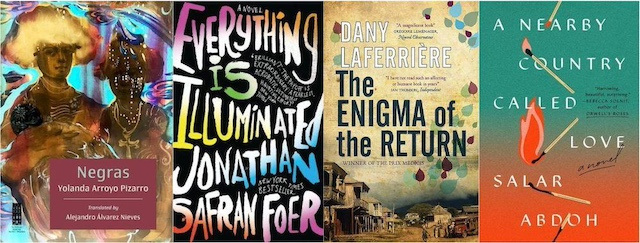Looking for Answers in a Haitian Seaside Town
Posted on February 28, 2024

Ever had a talkative cabdriver? How about for seven hours? That is what happens to Anaïse, the young protagonist of Lyonel Trouillot’s novel La Belle Amour Humaine (“The Beautiful Human Love”), who arrives in Haiti from an unnamed European country to unlock the mystery of her father’s past.
Anaïse is traveling from Haiti’s capital, Port-au-Prince, to her father’s home village in the north. The son of one of two “illustrious citizens” who lost their lives in a mysterious fire, her father left town shortly afterward, and died when Anaïse was a toddler.
Could he possibly have been involved in the deadly fire? And what is the true nature of his hometown, this seemingly sleepy, evocatively named, seaside village of Anse-à-Fôleur*? Thomas, the cabdriver, knows the place well, and warns Anaïse that her “Daughter of Pure Reason number” will get her nowhere.
A self-contained excerpt from the novel, translated by Linda Coverdale, is available online in the magazine Words Without Borders.
Contextualizing “La Belle Amour Humaine”

To help them learn more of the story’s background, you can have students follow the online prompts below, either before or after they first read the excerpt. You might have students work on individual prompts in small groups, and then reconvene to share what they learned.
- Want to see the route the driver takes from Haiti’s capital of Port-au-Prince to the seaside town of Anse-à-Fôleur? Follow along on Google Maps. As you get closer to Anse-à-Fôleur, click “Street View” to get a sense of the scenery.
- Watch Lyonel Trouillot discuss La Belle Amour Humaine in a video from the French publisher Actes Sud. (In French with auto-translated English subtitles. Select “subtitles,” “French,” and “auto-translate” in settings.)
The title La Belle Amour Humaine comes from an essay with the same name by Haitian author and activist Jacques Stephen Alexis. Read a short author bio and a passage from the essay, which is a hopeful address to humanity:
Happy new year, of course, to all those who suffer, fall, hope, and still believe.
Classroom Activities: Inferences and Imagination
In small groups, have students discuss what they can infer about Anse-à-Fôleur based on Thomas’s monologue. Next, ask them to discuss:
- What can they infer about Anaïse?
- About Thomas himself?
More advanced students can also examine the interplay of style and characterization in the depiction of Thomas: “What does Thomas’s way of speaking suggest about his character?”
Finally, have students look through images of northern Haiti, the region where Anse-à-Fôleur is located, and put together a collage that reflects Thomas’s description of the village.
- They may supplement the collage with their own illustrations if they wish.
- If they come across pictures of people who remind them of the characters in this excerpt, they can include those, too.
Students can work on the collage in small groups, but afterward, they should write individual reflections, responding to the question: “Which elements of Thomas’s description were easy to depict in a collage, and which were more difficult?”
Potential Assignments
- Creative writing: Write a monologue describing a place you know well and that is meaningful to you. It can be a town, a house, a building, a room, a forest, a beach, or any other place. The monologue can either be in your own voice or in the voice of an imagined character.
Advanced/Challenge: Have your speaker address a particular person, as in Trouillot’s excerpt. In the monologue, give readers a sense of what that other person is like. - Oral history: Interview a family or community member about a place that holds meaning in their lives. (Educators: students’ interviews could be assembled into a collection. Some examples and resources on oral history, in order of reading complexity, include: “Grass,” from South Korea; “An Interview with Wu Wenjian,” from China; and “The Wondrous Deer of the Eternal Hunt,” from Russia.)
Pairs well with . . .

You might teach this story alongside other depictions of homecomings and the search for roots, imbued with a similar sense of ambiguity. Interesting pairings with short readings on this website include:
- “Appointment in K City,” also a murder mystery of sorts, from China
- “Things Elude Me,” an Egyptian poem looking back at a former apartment
- “Where Have All the Sundays Gone?” a Japanese story about a woman’s return to a place where she experienced first love
Other explorations of these themes include Yolanda Arroyo Pizarro’s fictional reconstruction of ancestresses’ lives under slavery, entitled Negras (Las Negras); Jonathan Safran Foer’s novel Everything is Illuminated; Dany Laferrière’s novel The Enigma of the Return; and Salar Abdoh’s novel A Nearby Country Called Love.
Further Exploration:
Students interested in more of Trouillot’s novel can read “On the Sounds of Haiti,” another excerpt from the novel, published in Transition journal and translated by Laurent Dubois (bilingual in English and French on alternating pages).
*”Fôleur,” an Old French word, can be translated into “madness” or “folly.” “Anse” means “cove.”
By Nadia Kalman and Maggie Vlietstra, with research by Maggie Vlietstra.



